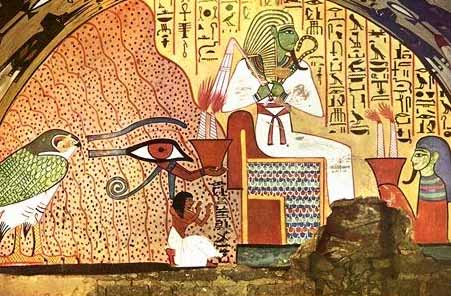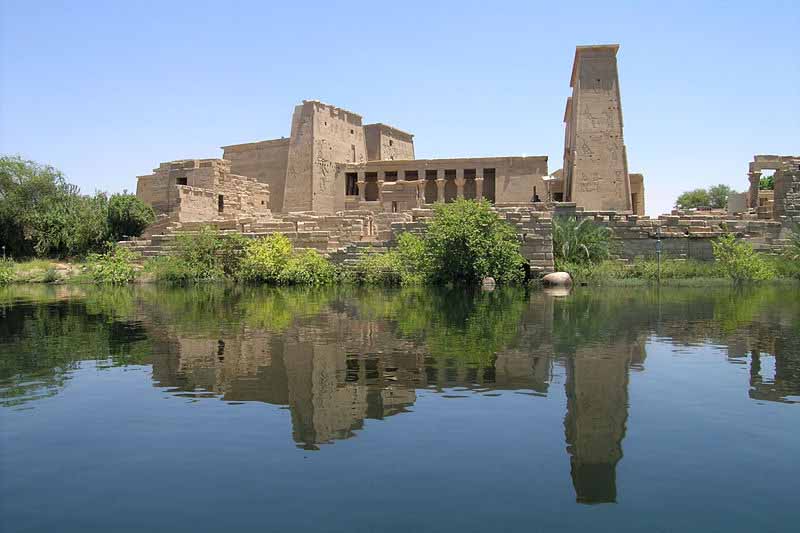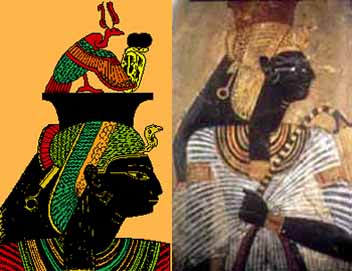Isis - Crystalinks (original) (raw)

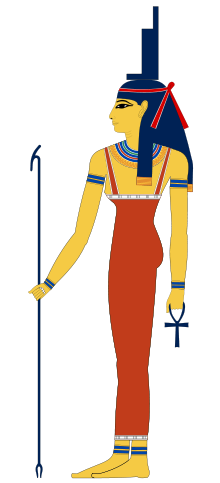
Isis is the feminine archetype for creation; she is the goddess of fertility and motherhood. She has gone by many names and played many roles in history and mythology - as goddess and female creator.
Her name literally means Queen of the Throne. Her original headdress was an empty throne chair belonging to her murdered husband, Osiris. As the personification of the throne, she was an important source of the Pharaoh's power. The pharaoh was depicted as her child, who sat on the throne she provided. Her cult was popular throughout Egypt, but the most important sanctuaries were at Behbeit El-Hagar in the Nile delta, and, beginning in the reign with Nectanebo I (380-362 BCE), on the island of Philae in Upper Egypt.

The hieroglyph for her name originally used meant (female) of flesh, i.e. mortal, and she may simply have represented deified, real, queens. The most commonly used name for this deity, Isis, is a Greek corruption of the Egyptian name; and its pronunciation as 'eye-sis' is a further corruption by English speakers. The true Egyptian pronunciation is unknown, as Egyptian hieroglyphs only recorded consonants, and left out most of the vowels. The Egyptian hieroglyphics for her name are commonly transliterated as jst; as a convenience, Egyptologists pronounce that as ee-set.
Isis is often shown as the mother of Horus,
the hawk-headed god of war and protection.
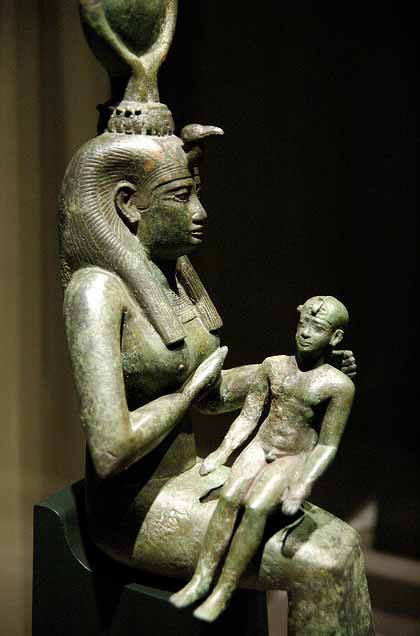
She is depicted suckling him much like this
depiction of the Virgin Mary with baby Jesus.
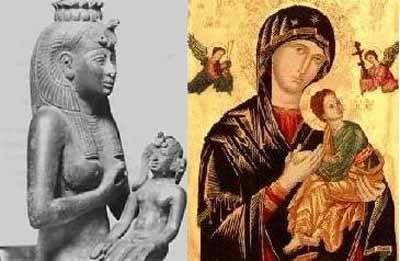
Isis was regarded as the companion of Osiris, 
whose soul dwelt in the star Sah or Orion.
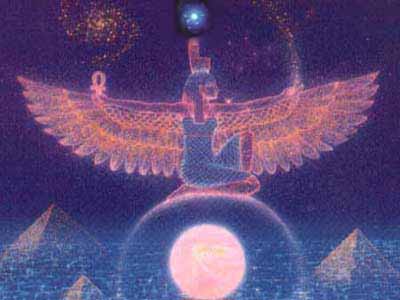
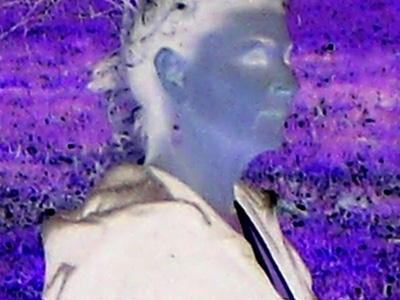
The symbol of Isis in the heavens was Sirius, known colloquially as the Dog Star reflecting its prominence in its constellation, Canis Major (Big Dog). Sirius was greatly beloved because its appearance marked not only the beginning of a New Year, but announced the annual Inundation of the Nile, which signified renewed wealth and prosperity for Egypt.
As the power which shot forth the Nile flood, she was called Sati.
As the embracer of the land and producer of fertility by her waters she was called Anqet.
As the goddess of cultivated lands and fields she was Sekhet.
As the goddess of the harvest she was Renenet.
As one linked to rebirth she was associated with the Phoenix.
As the producer and giver of life she was Ankhet.
As the great lady of the Underworld, who assisted in transforming the bodies of the blessed dead into those wherein they were to live in the realm of Osiris, she was Ament - the hidden goddess - mother of Ra. In this capacity she shared with Osiris the attribute of Giver of Life providing food for the dead as well as for the living.
At a comparatively early period in Egyptian history Isis had absorbed the attributes of all the great primitive goddesses, and of all the local goddesses such as Nekhebet, Uatchet, Net, Bast, Hathor, etc., and she was even identified as the female counterpart of the primeval abyss of water from which sprang all life. It is impossible to limit the attributes of Isis, who possesses the powers of a water goddess, an earth goddess, a corn goddess, a star goddess, a queen of the Underworld, and a woman, and that she united in herself one or more of the attributes of all the goddesses of Egypt known to us.
-
Isis was venerated first in Egypt - the only goddess worshiped by all Egyptians alike, and whose influence was so widespread that she had become completely syncretic with the Greek goddess Demeter. After the conquest of Egypt by Alexander the Great, and the Hellenization of the Egyptian culture initiated by Ptolemy I Soter, Isis eventually became known as Queen of Heaven.
Following the conquest of Egypt by Alexander the Great the worship of Isis spread throughout the Greco-Roman world. Tacitus writes that after Julius Caesar's assassination, a temple in honour of Isis had been decreed; Augustus suspended this, and tried to turn Romans back to the Roman deities who were closely associated with the state. Eventually the Roman emperor Caligula abandoned the Augustan wariness toward what was described as oriental cults, and it was in his reign that the Isiac festival of the Navigium Isidis was established in Rome.
According to Josephus, Caligula donned female garb and took part in the mysteries he instituted, and in the Hellenistic age Isis acquired a "new rank as a leading goddess of the Mediterranean world." Vespasian, along with Titus, practiced incubation in the Roman Iseum. Domitian built another Iseum along with a Serapeum. Trajan appears before Isis and Horus, presenting them with votive offerings of wine, in a bas-relief on his triumphal arch in Rome. Hadrian decorated his villa at Tibur with Isiac scenes. Galerius regarded Isis as his protector.
Roman perspectives on cults were syncretic, seeing in new deities, merely local aspects of a familiar one. For many Romans, Egyptian Isis was an aspect of Phrygian Cybele, whose orgiastic rites were long-naturalized at Rome, indeed, she was known as Isis of Ten Thousand Names. Among these names of Roman Isis, Queen of Heaven is outstanding for its long and continuous history. Herodotus identified Isis with the Greek and Roman goddesses of agriculture, Demeter and Ceres.
In later years, Isis also had temples throughout Europe, Africa and Asia. An alabaster statue of Isis from the 3rd century BCE, found in Ohrid, in the Republic of Macedonia, is depicted on the obverse of the Macedonian 10 denars banknote, issued in 1996. The male first name "Isidore", means in Greek "gift of Isis" (similar to "Theodore", "God's gift"). The name, which became common in Roman times, survived the suppression of the Isis worship and remains popular up to the present � being among others the name of several Christian saints. The Isis cult in Rome was a template for the Christian Madonna Cult.
Origins
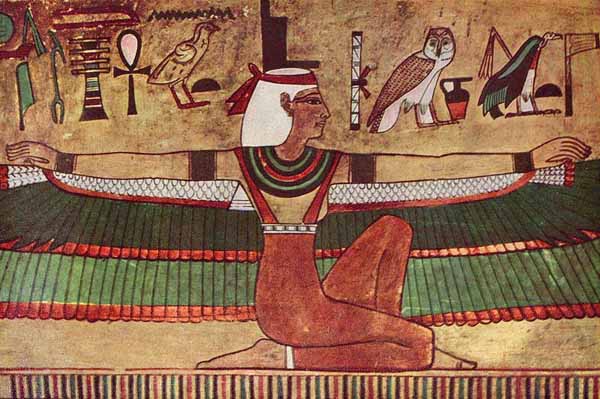
In the typical form of her myth, Isis was the first daughter of Geb, god of the Earth, and Nut, goddess of the Sky, and she was born on the fourth intercalary day. She married her brother, Osiris, and she conceived Horus by him. Isis was instrumental in the resurrection of Osiris when he was murdered by Set. Using her magical skills, she restored his body to life after having gathered the body parts that had been strewn about the earth by Set.
Most Egyptian deities were first worshipped by local cults, eventually their popularity spread - so that most major cities and towns in Egypt were known as the home of a particular deity. The origins of the cult of Isis are uncertain, but it is believed that she was originally an independent and popular deity in predynastic times, prior to 3100 BCE, at Sebennytos in the Nile delta.
The first written references to Isis date back to the Fifth dynasty of Egypt. Based on the association of her name with the throne, some early Egyptologists believed that Isis's original function was that of throne-mother. However, more recent scholarship suggests that aspects of that role came later by association. In many African tribes, the throne is known as the mother of the king, and that concept fits well with either theory, possibly giving insight into the thinking of ancient Egyptians.
The Isis-Osiris Myth myth became very important during the Greco-Roman period with sanctuaries at Delos and Pompeii. It was believed that the Nile River flooded every year because of the tears of sorrow which Isis wept for Osiris. Osiris's death and rebirth was relived each year through rituals. The worship of Isis eventually spread throughout the Greco-Roman world, continuing until the suppression of paganism in the Christian era.
Classical Egyptian Period
In the Book of the Dead, Isis was described as She who gives birth to heaven and earth, knows the orphan, knows the widow, seeks justice for the poor, and shelter for the weak.
During the Old Kingdom period, Isis was represented as the wife or assistant to the deceased pharaoh. Thus she had a funerary association, her name appearing over eighty times in the pharaoh's funeral texts (the Pyramid Texts). This association with the pharaoh's wife is consistent with the role of Isis as the spouse of Horus, the god associated with the pharaoh as his protector, and then later as the deification of the pharaoh himself.
But in addition, Isis was also represented as the mother of the "four suns of Horus", the four deities who protected the canopic jars containing the pharaoh's internal organs. More specifically, Isis was viewed as the protector of the liver-jar-deity, Imsety. By the Middle Kingdom period, as the funeral texts began to be used by members of Egyptian society other than the royal family, the role of Isis as protector also grew, to include the protection of nobles and even commoners.
By the New Kingdom period, the role of Isis as a mother deity had displaced that of the spouse. She was seen as the mother of the pharaoh, and was often depicted breastfeeding the pharaoh. It is theorized that this displacement happened through the merging of cults from the various cult centers as Egyptian religion became more standardized. When the cult of Ra rose to prominence, with its cult center at Heliopolis, Ra was identified with the similar deity, Horus. But Hathor had been paired with Ra in some regions, as the mother of the god. Since Isis was paired with Horus, and Horus was identified with Ra, Isis began to be merged with Hathor as Isis-Hathor. By merging with Hathor, Isis became the mother of Horus, as well as his wife. Eventually the mother role displaced the role of spouse. Thus, the role of spouse to Isis was open and in the Heliopolis pantheon, Isis became the wife of Osiris and the mother of Horus/Ra. This reconciliation of themes led to the evolution of the myth of Isis and Osiris.
The Myth of Isis and Osiris
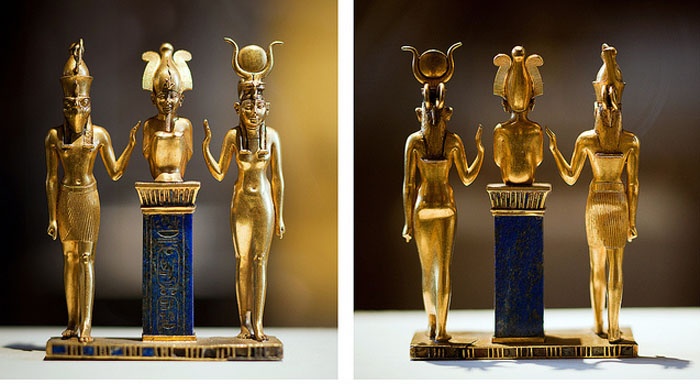
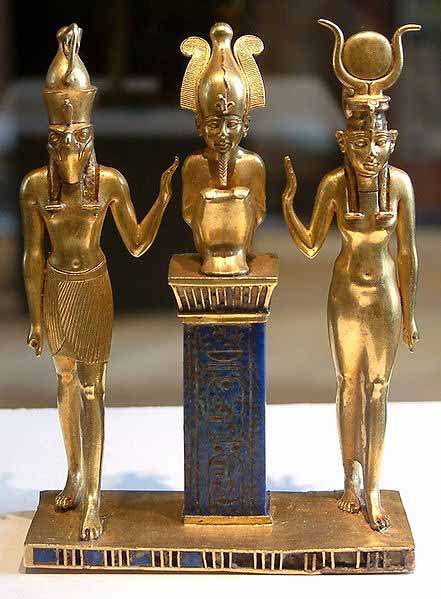
The family of Osiris. Osiris on a lapis lazuli pillar in the middle,
flanked by Horus on the left and Isis on the right (Louvre, Paris)
This myth has been told in various ways, but the message is aways the same - death and resurrection a metaphor for the journey of the soul in the games of physical reality.
The Myth of Isis, Osiris, and Horus became one of the most important and powerful in Egyptian mythology during the New Kingdom. The myth concerns the death of Osiris and the birth of Horus.
The original form of the myth states that Osiris was killed by a wooden sarcophagus secretly being made to his measurements by Set, who was jealous of Osiris's position as Pharaoh, and so plotted to kill him and take his place. A party had been held where the coffin was offered to whoever could fit inside. A few people tried to fit in, but to no avail. Osiris was encouraged to try, but as soon as he lay back, the lid slammed on him and was locked. It was then sealed with lead and thrown into the Nile river.
Upon hearing that Osiris was gone, Isis set out to look for him. She was afraid that without proper ceremonies and burial Osiris would not be able to go to the place of the dead. She later learned that the coffin had floated down the Nile river up to the coast of Byblos (now in modern day Lebanon) and became embedded in the trunk of a cedar tree. She also learned that the cedar tree had been taken and used as a pillar to support a palace for the king of Byblos. When traveling back, along the Nile River, she left the coffin in an area of marshland. Set, while hunting, found Osiris's coffin and dismembered him into 14 parts, scattering them across the land of Egypt.
Once again Isis set out to look for the pieces and she was able to find 13 of the 14 parts, with the help of Nephthys, Seth's sister-wife, but was unable to find the 14th, as it had been eaten by a fish. Instead, she fashioned a phallus out of gold and sang a song around Osiris until he came back to life. Osiris was resurrected. He could have proper ceremonies and burial. Due to this experience, Osiris became Lord of the Dead and the Afterlife.
In late Egyptian thought, the righteous dead were sometimes said to become the stars, and thus the moon was occasionally seen as having a connection to Osiris, lord of the dead. As a death and resurrection legend, in which evil seeks to destroy a deity, thus bringing darkness, it thus developed an association with the lunar cycle, in which the moon appears to be destroyed by darkness, and is then brought back to life. Thus it later became said that Osiris had been killed by being dismembered into 13 parts, each part representing one of the 13 full moons seen each year (there are roughly 13 lunar months per year). Another interpretation is that the pieces were 14 (they number up to sixteen in some versions) were the phases of a single moon's cycle (one sliver cut off each night for 14 days, then reassembled over the next 14 days. The original form of Set's murder of Osiris was incorporated into this later version, though it was said that the attempt had failed when Isis and Nepthys found the coffin and rescued it.
Consequently, the story became that before resurrecting Osiris, Isis put together 13 of the 14 parts, but was unable to find the 14th, his phallus, which was eaten by the oxyrhynchus fish (a fish with an unusual curved snout resembling depictions of Set). So Isis created a phallus for him, and then attempted to revive him. In some versions, Isis sang a song around Osiris until he came back to life. She then took the form of a kite and flew around his body in order to conceive Horus. In other tellings of the story, Isis grows wings and hovers over Osiris. She breathes life into him in order to revive him and conceive Horus. Being simultaneously alive and dead, Osiris became the god and king of the afterlife.
As a life-death-rebirth deity, Horus/Osiris became a reflection of the annual cycle of crop harvesting as well as reflecting people's desires for a successful afterlife, and so the legend became extremely important, outstripping all others. The legend's ventures into both life and afterlife meant that religious rites associated with the legend eventually began to take on aspects of a mystery religion, where initiates were said to be able to partake in Horus/Osiris' resurrection, purging themselves of past ills, and entering a new life.
In Greece, the Demeter-Persephone death-resurrection cult at Eleusis, had a similar nature, and began at approximately the same time. Many centuries later this led to interest in the Egyptian cult by the Greeks, including Plato. Eventually, a derived form of the Egyptian cult, having been infused with Platonism, spread to areas of Greek influence, particularly during the Hellenistic era of control over Egypt. As the cult referred to foreign gods, the forms of the cult in Greek nations were adopted to describe suitable local deities and merged and expanded to include elements from the local cultures. This produced a collection of closely related versions of the cult, whose central deities had been deformed to be similar to the Egyptian cult, and were by the 1st century BC collectively known as Osiris-Dionysus.
Late Antiquity
The cult of Isis became very prominent in late antiquity, when it began to absorb the cults of many other goddesses with strong cult centers. Like other Egyptian deities, the cult of Isis spread outside Egypt, and became the focus of a centralized cult in the Hellenistic period. This is when the cult of Osiris became widespread as well. Temples to Isis began to be built outside of Egypt. In many locations, devotees of Isis considered the local goddess to be Isis, but under a different name.
To the Greeks she was known as Demeter - to the Romans as Ceres - though she played other goddess roles in all ancient civilizations. Other Mediterranean goddesses, such as Demeter, Astarte, and Aphrodite, were also identified with her. Throughout the Greco-Roman world, the cult of Isis became one of the most significant of the mystery religions, and many classical writers refer to her temples, cults, and rites.
Due to her attributes as a protector and mother, as well as a lusty aspect gained when she absorbed some aspects of Hathor, she became the patron goddess of sailors, who spread her worship with the trading ships circulating the Mediterranean Sea.
During the formative centuries of Christianity, the religion of Isis drew converts from every corner of the Roman Empire. In Italy itself, Egyptian religion was an important force. At Pompeii, archaeological evidence reveals that the cult of Isis was prominent. In Rome, temples were built and obelisks erected in her honor. In Greece, traditional centres of worship in Delos, Delphi, Eleusis and Athens were taken over by followers of Isis, and this occurred in northern Greece as well. Harbors of Isis were to be found on the Arabian Sea and the Black Sea. Inscriptions show followers in Gaul, Spain, Pannonia, Germany, Arabia, Asia Minor, Portugal and many shrines even in Britain.
Temples and Priesthood
Temples dedicated to Isis were built in Iraq, Greece and Rome, with a well preserved example discovered in Pompeii. On the Greek island of Delos a Doric Temple of Isis was built on a high over-looking hill at the beginning of the Roman period to venerate the familiar trinity of Isis, the Alexandrian Serapis and Harpocrates. The creation of this temple is significant as Delos is particularly known as the birthplace of the Greek gods Artemis and Apollo who had temples of their own on the island long before the temple to Isis was built.
The cult of Isis and Osiris continued up until the 6th century CE on the island of Philae in Upper Nile. The Theodosian decree (in about 380 CE) to destroy all pagan temples was not enforced there until the time of Justinian. This toleration was due to an old treaty made between the Blemyes-Nobadae and Diocletian. Every year they visited Elephantine and at certain intervals took the image of Isis up river to the land of the Blemyes for oracular purposes before returning it. Justinian sent Narses to destroy the sanctuaries, with the priests being arrested and the divine images taken to Constantinople. Philae was the last of the ancient Egyptian temples to be closed. Little information on Egyptian rituals for Isis survives; however, it is clear there were both priests and priestesses officiating at her cult throughout its history.
Temple of Isis (Pompeii)
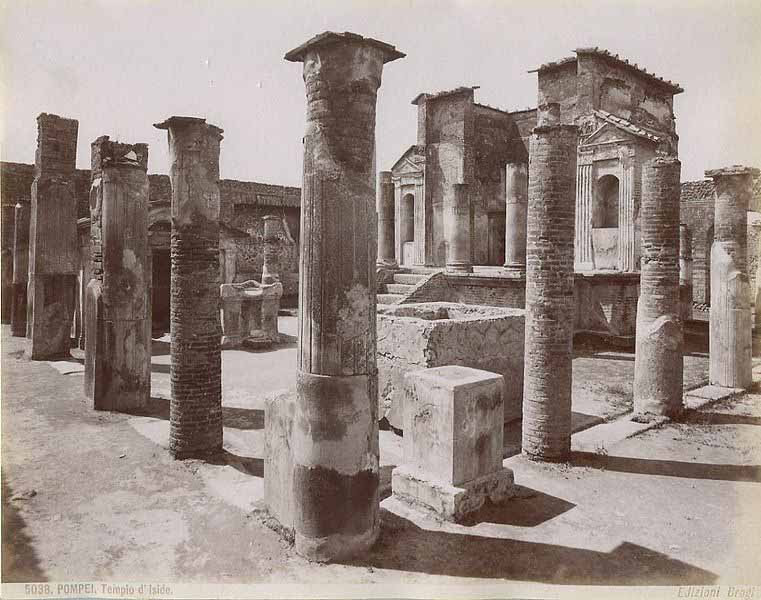
By the Greco-Roman era, many of the priests were considered healers, said to have other special powers, including dream interpretation and the ability to control the weather, which they did by braiding or not combing their hair. The latter was believed because the Egyptians considered knots to have magical powers.
The Temple of Isis is a Roman temple dedicated to the Egyptian goddess Isis. This small and almost intact temple was among one of the first discoveries during the excavation of Pompeii in 1764. Its role as a Hellenized Egyptian temple in a Roman colony was fully confirmed with an inscription detailed by Francisco la Vega on July 20, 1765. Original paintings and sculptures can be seen at the Museo Archaeologico in Naples; the site itself remains on the Via del Tempio di Iside. In the aftermath of the temple's discovery many well-known artists and illustrators swarmed to the site.
The preserved Pompeian temple is actually the second structure; the original building built under Augustan was damaged in an earlier earthquake of 62 CE. Seventeen years later with the massive volcanic eruption, the Iseum alone was the sole temple to be completely re-built - ahead even of the Capitolium. Although the Iseum was wedged into a small and narrow space, it received significant foot traffic from theater-goers at the Large Theater, businessmen in the Triangular Forum, and others along the Stabian Gate.
Principal devotees of this temple are assumed to be women, freedmen, and slaves. Initiates of the Isis mystery cult worshipped a compassionate goddess who promised eventual salvation and a perpetual relationship throughout life and after death. The temple itself was reconstructed in honor of a 6 year-old boy by his freedman father, Numerius, to allow the child to enter elite society. Many scenes from the temple are re-created in the dining rooms of Pompeians, however, indicating that many individuals visited this temple for political, economic, or social reasons.
Isis was a goddess in Ancient Egyptian religious beliefs, whose worship spread throughout the Greco-Roman world. She was worshipped as the ideal mother, wife, the matron of nature and magic. She was the friend of slaves, sinners, artisans, the downtrodden, who also listened to the prayers of the wealthy, maidens, aristocrats and rulers. Isis worship was concerned about the acquisition of knowledge since knowledge could only be attained from the gifts of the gods
Priests of Isis typically shaved their heads and wore linen garments rather than wool. Isis worship did not include a Messianic worldview but it did provide a relationship with the divine that was not ruptured with death. In common with other deities Isis did not demand exclusive worship but in practice her devotees applied, from a modern perspective, an henotheistic outlook.
The cult of Isis is thought to arrived in Pompeii around 100 BCE. Following the destruction of the first temple in the earthquake of 62 CE the son of Numerous paid for its complete reconstruction. The setting and adornments provided an attractive backdrop for the liturgical rites. These services occurred daily with a solemn morning opening and a nightly closing filled with singing.
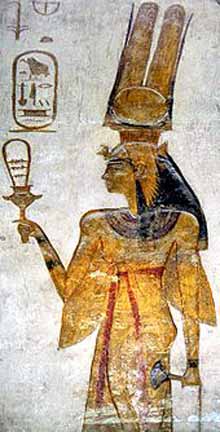
A ritual bucket for holy Nile water, the situla, and a rattle, the sistrum, were both used in worship. It is known that the Temple of Isis was the most variable one because of Isis' worship.
Knot of Isis

Because of the association between knots and magical power, a symbol of Isis was the Tiet or Tyet - meaning welfare or life, also called the Knot of Isis, Buckle of Isis, or Blood of Isis. The Tiet represents the concept of eternal life or resurrection. The meaning of Blood of Isis is more obscured, but the Tyet was often used as a funerary amulet made of red wood, stone, or glass, so this may have simply been a description of its appearance.
Art
In art, originally Isis was pictured as a woman wearing a long sheath dress and crowned with the hieroglyphic sign for a throne. Sometimes she was depicted as holding a lotus, or, as a Sycamore tree. One pharaoh, Thutmose III, was depicted in his tomb as nursing from a sycamore tree that had a breast.
After she assimilated many of the roles of Hathor, Isis's headdress is replaced with that of Hathor: the horns of a cow on her head, with the solar disk between them. Sometimes she also was represented as a cow, or a cow's head. Usually, however, she was depicted with her young child, Horus (the pharaoh), with a crown, and a vulture. Occasionally she was represented as a kite flying above the body of Osiris or with the dead Osiris across her lap as she worked her magic to bring him back to life.
Most often Isis is seen holding only the generic ankh sign and a simple staff, but in late images she is seen sometimes with items usually associated only with Hathor, the sacred and the fertility-bearing necklace. In The Book of Coming Forth Isis is depicted standing on the prow of the Solar Bark with her arms outstretched.
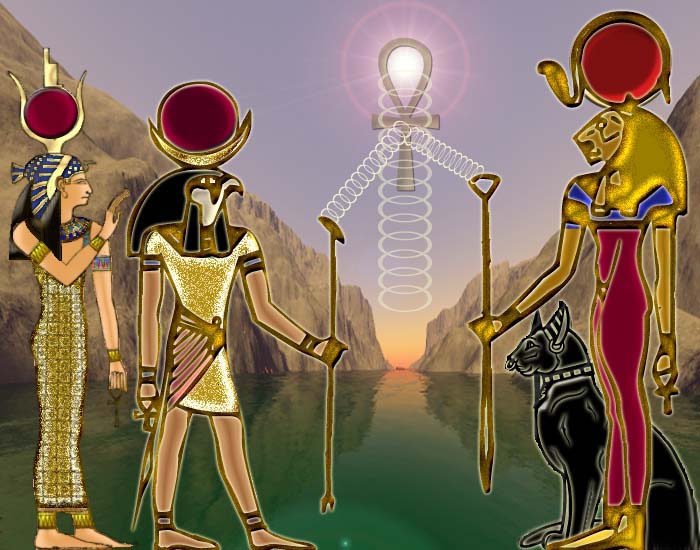
Magic
It was said that Isis tricked Ra (i.e. Amun-Ra/Atum-Ra) into telling her his "secret name," by causing a snake to bite him, for which only Isis had the cure. Knowing the secret name of a deity enabled one to have power of the deity. The use of secret names became central in late Egyptian magic spells, and Isis often is implored to "use the true name of Ra" in the performance of rituals. By the late Egyptian historical period, after the occupations by the Greeks and the Romans, Isis became the most important and most powerful deity of the Egyptian pantheon because of her magical skills. Magic is central to the entire mythology of Isis, arguably more so than any other Egyptian deity.
Prior to this late change in the nature of Egyptian religion, the rule of Ma'at had governed the correct actions for most of the thousands of years of Egyptian religion, with little need for magic. Thoth had been the deity who resorted to magic when it was needed. The goddess who held the quadruple roles of healer, protector of the canopic jars, protector of marriage, and goddess of magic previously had been Serket.

She then became considered an aspect of Isis. Thus it is not surprising that Isis had a central role in Egyptian magic spells and ritual, especially those of protection and healing. In many spells, she also is completely merged even with Horus, where invocations of Isis are supposed to involve Horus's powers automatically as well. In Egyptian history the image of a wounded Horus became a standard feature of Isis's healing spells, which typically invoked the curative powers of the milk of Isis.
Myth, Math, Metaphor, and Magic
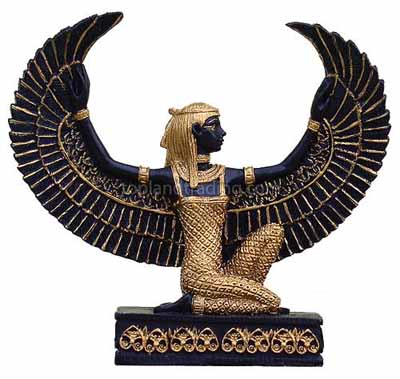
The myth of Isis represents our feminine attributes - intuition, psychic abilities, love, compassion, yin energies, mother nurturer, the high priestess, the metaphoric goddess in all creation myths. She is the essence of the feminine energy which is part of us all. Isis is the Eye of Horus. Osiris - 'O'=completion of Isis's work on this level of consciousness in the hologram of our reality. Never forget, it's all illusion and includes Ancient Alien Theory.
